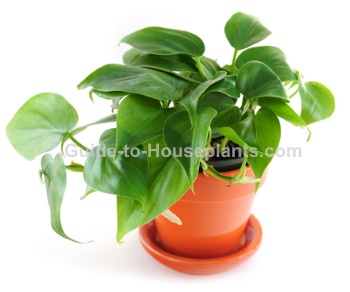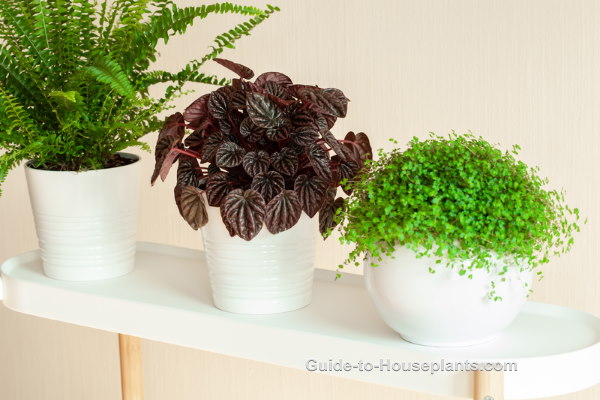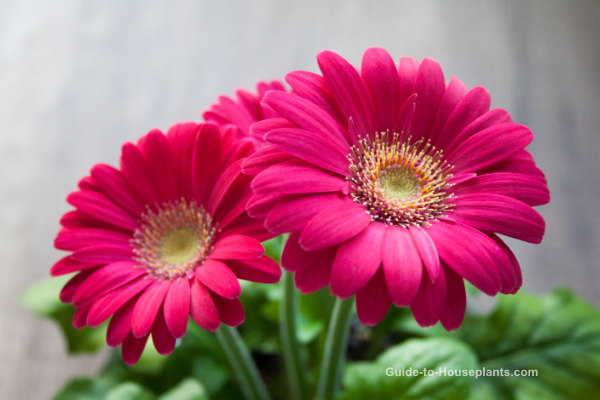Heartleaf Philodendron Care
Heartleaf philodendron is a popular house plant because it is extremely easy to grow. It's also known as the Sweetheart Plant.
In this guide, you'll discover how to water, when to repot, and why you'll want to pinch your plant.

Get to Know Heartleaf Philodendron
Heart-shaped, glossy leaves emerge bronze, then quickly turn green. The leaves are typically 2-4 in (5-10 cm) long, and cover its long, slender stems that can grow to 4 ft (1.2 m) or more.
Pinch your plant. Without pinching, it will grow with long, single stems and become lanky. You can pinch it back anytime to help it branch out, keeping the plant bushy and full. Always pinch after a leaf node (the place where a leaf is attached to the stem). A new stem will grow from that node.
Pinching tip: Try to pinch close to the node because any bare stem that is left will die, and the node will not grow a new stem. Make a clean cut -- you want to avoid jagged tears, which can attract disease. You can use your fingernails to pinch, or use sharp scissors or pruners.
Or let it grow. Few house plants are as eager to climb as a heartleaf philodendron. If you allow the long stems to grow, put the plant in a hanging basket, or let it trail from a shelf or bookcase. To train it to climb a moss pole, use floral tape or soft plant ties to hold the stems up to the pole, until its aerial roots sink in.
It will thrive in a small pot for a couple years with little care. Despite its tropical origins, this beautiful evergreen plant is tolerant of dry air, although it appreciates occasional misting. Keep its leaves clean by wiping them with a damp cloth.
Wondering whether to repot? It's definitely time to repot every 2-3 years, in spring or early summer. Use a container with drainage holes to prevent root rot. If you want to use a decorative container without drainage, use it as a cachepot -- just slip your plain nursery pot into the cachepot. I like to cover the bottom of a cachepot with pebbles to keep the plant above the drainage water.
Problems and Solutions for Heartleaf Philodendron
Wilted leaves are likely because the potting medium has dried out. Although it will tolerate dry soil, I wouldn't let it go too long without a drink. Another possibility for wilting is root rot.
Yellow leaves are caused by prolonged soggy soil. Overwatering is the number one reason houseplants die. But it's easy to avoid. Use a pot with drainage holes, water thoroughly then empty the drainage tray.
Brown scorch marks on leaves may be a symptom of exposure to hot, direct sunlight. Or brown spots may be caused by fungus. If you mist your plant, or clean it with water, don't allow water drops to stay on the leaves. While foliage dries quickly outdoors with good air circulation, indoor plants may stay wet for several hours, leading to fungus. It's a good idea to cut off affected leaves. Don't worry -- this vigorous vine will soon replace them.
Something bugging your plant? The only problem I've had with this easy-going philodendron is fungus gnats. Those tiny, black insects are attracted to wet, peaty potting mixes. They're difficult to see, but you may find them crawling on the surface. This plant is somewhat drought-tolerant, so I allowed the top couple inches of potting medium to dry out and the fungus gnats disappeared. Aphids are attracted to new growth on soft-stemmed plants, like this one. Treat any infestation right away to avoid pests from traveling on to your other indoor plants.
Heartleaf Philodendron Care Tips
Origin: South America
Height: Climbs or trails to 4 ft (1.2 m) or more.
Light: Moderate to bright light. Small leaves or long spaces between leaves show that the plant is not getting enough light. Move heartleaf philodendron plant to a brighter location, but not into direct sun which can scorch its leaves. It thrives under fluorescent light, too, making it an ideal office plant.
Water: Keep soil lightly moist spring through fall. Allow surface to dry out between waterings in winter. Yellow leaves are caused by overwatering. Always use tepid water for your houseplants because cold water is a shock to these tropical natives.
Humidity: Tolerant of dry air, but likes humidity. Try to maintain 40% relative humidity or higher. Check out these easy ways to raise the humidity around your tropical plants. Brown leaf tips are a symptom of dry air.
Temperature: Average room temperatures (65-75°F/18-24°C). Heartleaf philodendron will tolerate a minimum of 60°F/16°C.
Soil: Peat moss-based mix, such as African violet potting mix.
Fertilizer: Feed monthly spring through fall with a balanced liquid or water-soluble fertilizer, diluted by half. Don't feed in winter, when growth is slower.
Propagation: Take 3-4 in/7-10 cm-long stem tip cuttings (each with at least 3 leaves attached) in spring or early summer. Cut just below a leaf node (the place where the leaf is attached to the stem). Nodes contain cells that will develop new roots. Philodendron roots easily in water or moist soil.

